Architectonic features and relative locations of primary sensory and related areas of neocortex in mouse lemurs
- PMID: 29484648
- PMCID: PMC6109619
- DOI: 10.1002/cne.24419
Architectonic features and relative locations of primary sensory and related areas of neocortex in mouse lemurs
Abstract
Mouse lemurs are the smallest of the living primates, and are members of the understudied radiation of strepsirrhine lemurs of Madagascar. They are thought to closely resemble the ancestral primates that gave rise to present day primates. Here we have used multiple histological and immunochemical methods to identify and characterize sensory areas of neocortex in four brains of adult lemurs obtained from a licensed breeding colony. We describe the laminar features for the primary visual area (V1), the secondary visual area (V2), the middle temporal visual area (MT) and area prostriata, somatosensory areas S1(3b), 3a, and area 1, the primary motor cortex (M1), and the primary auditory cortex (A1). V1 has "blobs" with "nonblob" surrounds, providing further evidence that this type of modular organization might have evolved early in the primate lineage to be retained in all extant primates. The laminar organization of V1 further supports the view that sublayers of layer 3 of primates have been commonly misidentified as sublayers of layer 4. S1 (area 3b) is proportionately wider than the elongated area observed in anthropoid primates, and has disruptions that may distinguish representations of the hand, face, teeth, and tongue. Primary auditory cortex is located in the upper temporal cortex and may include a rostral area, R, in addition to A1. The resulting architectonic maps of cortical areas in mouse lemurs can usefully guide future studies of cortical connectivity and function.
Keywords: RRID_ AB_177621; RRID_ AB_2313581; RRID_AB_2313581; RRID_AB_2564642; RRID_AB_477329; auditory cortex; primates; prosimian evolution; somatosensory cortex; visual cortex.
© 2018 Wiley Periodicals, Inc.
Conflict of interest statement
The authors declare no conflict of interest.
Figures
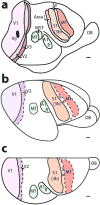



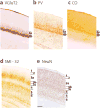

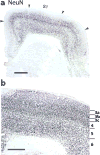
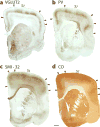


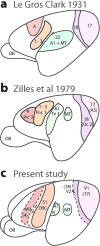
Similar articles
-
Architectonic subdivisions of neocortex in the tree shrew (Tupaia belangeri).Anat Rec (Hoboken). 2009 Jul;292(7):994-1027. doi: 10.1002/ar.20916. Anat Rec (Hoboken). 2009. PMID: 19462403 Free PMC article.
-
Evolution of somatosensory and motor cortex in primates.Anat Rec A Discov Mol Cell Evol Biol. 2004 Nov;281(1):1148-56. doi: 10.1002/ar.a.20120. Anat Rec A Discov Mol Cell Evol Biol. 2004. PMID: 15470673 Review.
-
The evolution of brains from early mammals to humans.Wiley Interdiscip Rev Cogn Sci. 2013 Jan;4(1):33-45. doi: 10.1002/wcs.1206. Epub 2012 Nov 8. Wiley Interdiscip Rev Cogn Sci. 2013. PMID: 23529256 Free PMC article. Review.
-
Somatosensory cortex of prosimian Galagos: physiological recording, cytoarchitecture, and corticocortical connections of anterior parietal cortex and cortex of the lateral sulcus.J Comp Neurol. 2003 Mar 10;457(3):263-92. doi: 10.1002/cne.10542. J Comp Neurol. 2003. PMID: 12541310
-
Laminar and cytoarchitectonic features of the cerebral cortex in the Risso's dolphin (Grampus griseus), striped dolphin (Stenella coeruleoalba), and bottlenose dolphin (Tursiops truncatus).J Anat. 2008 Sep;213(3):241-8. doi: 10.1111/j.1469-7580.2008.00936.x. Epub 2008 Jul 9. J Anat. 2008. PMID: 18625031 Free PMC article.
Cited by
-
Orientation Preference Maps in Microcebus murinus Reveal Size-Invariant Design Principles in Primate Visual Cortex.Curr Biol. 2021 Feb 22;31(4):733-741.e7. doi: 10.1016/j.cub.2020.11.027. Epub 2020 Dec 3. Curr Biol. 2021. PMID: 33275889 Free PMC article.
-
The inevitable inequality of cortical columns.Front Syst Neurosci. 2022 Sep 20;16:921468. doi: 10.3389/fnsys.2022.921468. eCollection 2022. Front Syst Neurosci. 2022. PMID: 36203745 Free PMC article.
-
The postnatal development of MT, V1, LGN, pulvinar and SC in prosimian galagos (Otolemur garnettii).J Comp Neurol. 2020 Dec 1;528(17):3075-3094. doi: 10.1002/cne.24885. Epub 2020 Feb 24. J Comp Neurol. 2020. PMID: 32067231 Free PMC article.
-
Not all cortical expansions are the same: the coevolution of the neocortex and the dorsal thalamus in mammals.Curr Opin Neurobiol. 2019 Jun;56:78-86. doi: 10.1016/j.conb.2018.12.003. Epub 2019 Jan 15. Curr Opin Neurobiol. 2019. PMID: 30658218 Free PMC article. Review.
-
Strengths and Weaknesses of the Gray Mouse Lemur (Microcebus murinus) as a Model for the Behavioral and Psychological Symptoms and Neuropsychiatric Symptoms of Dementia.Front Pharmacol. 2019 Oct 30;10:1291. doi: 10.3389/fphar.2019.01291. eCollection 2019. Front Pharmacol. 2019. PMID: 31736761 Free PMC article. Review.
References
-
- Allman JM, Kaas JH. Representation of the visual field in striate and adjoining cortex of the owl monkey (Aotus trivirgatus) Brain Research. 1971;35(1):89–106. - PubMed
-
- Allman JM, Kaas JH, Lane RH. The middle temporal visual area (MT) in the bush baby, Galago senegalensis. Brain Res. 1973;57:197–202. - PubMed
-
- Allman J. Variations in visual cortex organization in primates. Neurobiology of Neocortex. 1988:249–40.
-
- Azevedo FA, Carvalho LR, Grinberg LT, Farfel JM, Ferretti RE, Leite RE, Herculano Houzel S. Equal numbers of neuronal and nonneuronal cells make the human brain an isometrically scaled up primate brain. Journal of Comparative Neurology. 2009;513(5):532–541. - PubMed
Publication types
MeSH terms
Substances
Grants and funding
LinkOut - more resources
Full Text Sources
Other Literature Sources
Miscellaneous

